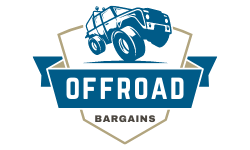
A Complete Guide to Hiking the Tour Du Mont Blanc
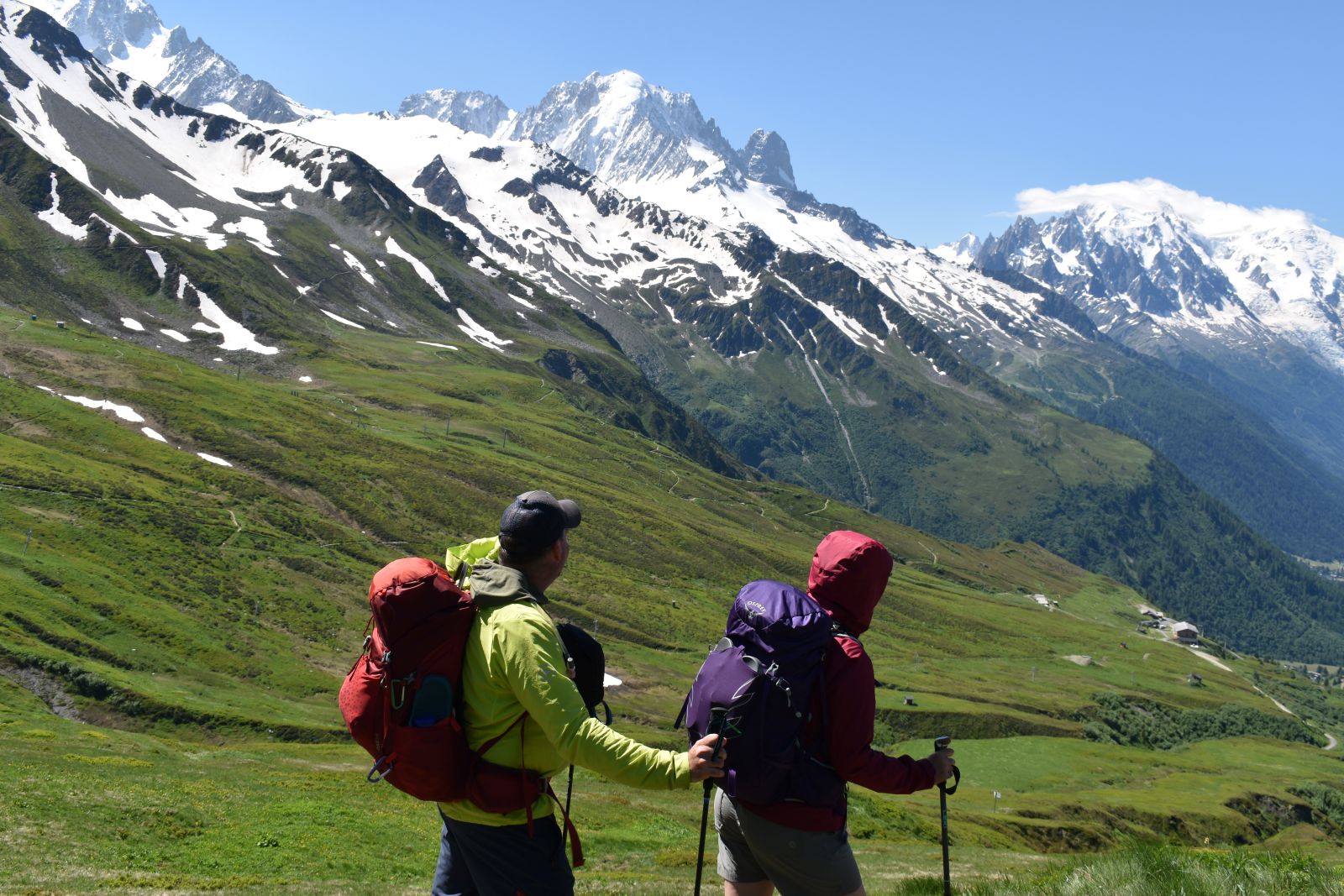
The Tour du Mont Blanc is an iconic hike that circles the highest Alp in Western Europe, Mont Blanc. Along this hundred-mile route, you’ll pass through three countries – France, Italy, and Switzerland – while savoring some of the planet’s most stunning alpine scenery. By day, you’ll traverse everything from high mountain passes to ancient Roman roads, dairy farms, and quaint villages. By night, you can enjoy a campsite – or splurge on a remote mountain refuge where you can enjoy a shower, bed, and 4-course meal with local wines, farm-fresh produce, and hearty alpine table fare.
Whether you backpack it or day hike it from hut to hut, the TMB (as most people call it) is a bucket list hike. We’ll never forget our TMB experience after completing the full Tour last year. However, most travelers find the hike physically challenging. And planning your TMB trip can be even more challenging than the hike itself!
That’s why we’ve created this guide to hiking the Tour du Mont Blanc. Based on our personal experience, our guide walks you through key decision points, provides booking advice, and helps you pack for what could be the best hike of your life.

Quick Facts
- Distance: 106 miles (170km)
- Days Needed: 10-12 (average)
- Peak Elevation: 8,307 ft
- Elevation Gain/Loss: 35,000 feet (10,600m)
- Best Time to Hike: June 25 – September 15
- Permits: None
- Difficulty: Moderately Difficult
- Accommodations: Choice of campsites, rifugios (mountain huts/dorms), hotels, inns
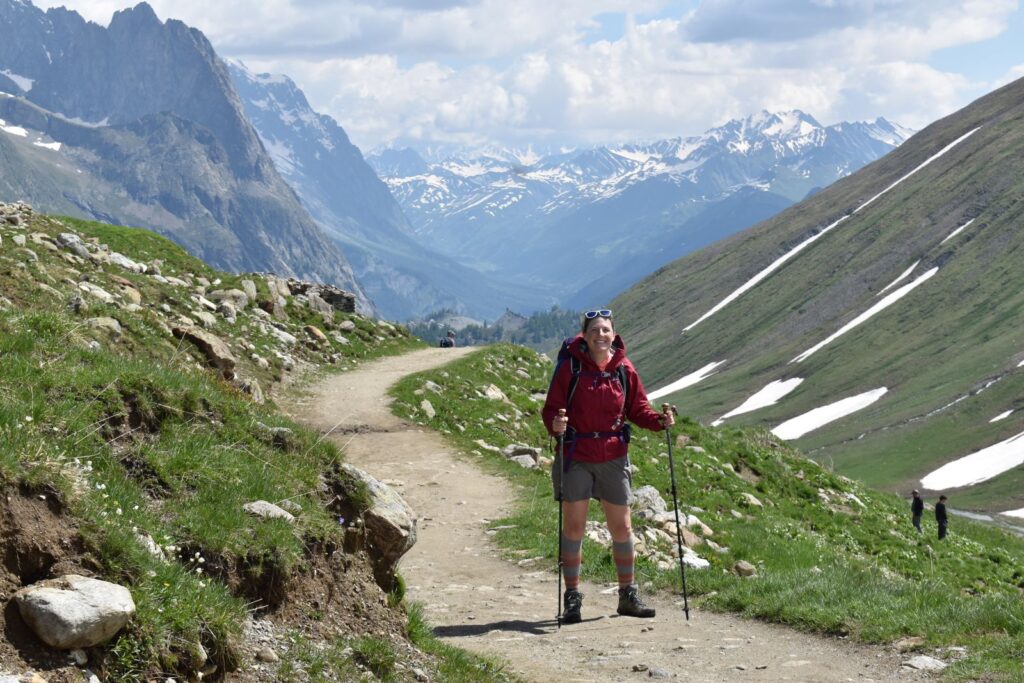
Highlights
- Visiting three countries on a single hike
- Alpine scenery, especially in the French and Italian stages
- Beds, showers, drinks, multi-course meals for hut-to-hut hikers
- Food and water readily available to backpackers
- Optional variants with bigger views and smaller crowds
- Customizable routes using public transportation hacks
Lowlights
- Crowds – this is Europe’s most popular multi-day hike
- Logistical challenges of booking accommodations
- Different backpacking regulations for each country
- Unpredictable mountain weather
- Swiss stages not as scenic as French and Italian stages
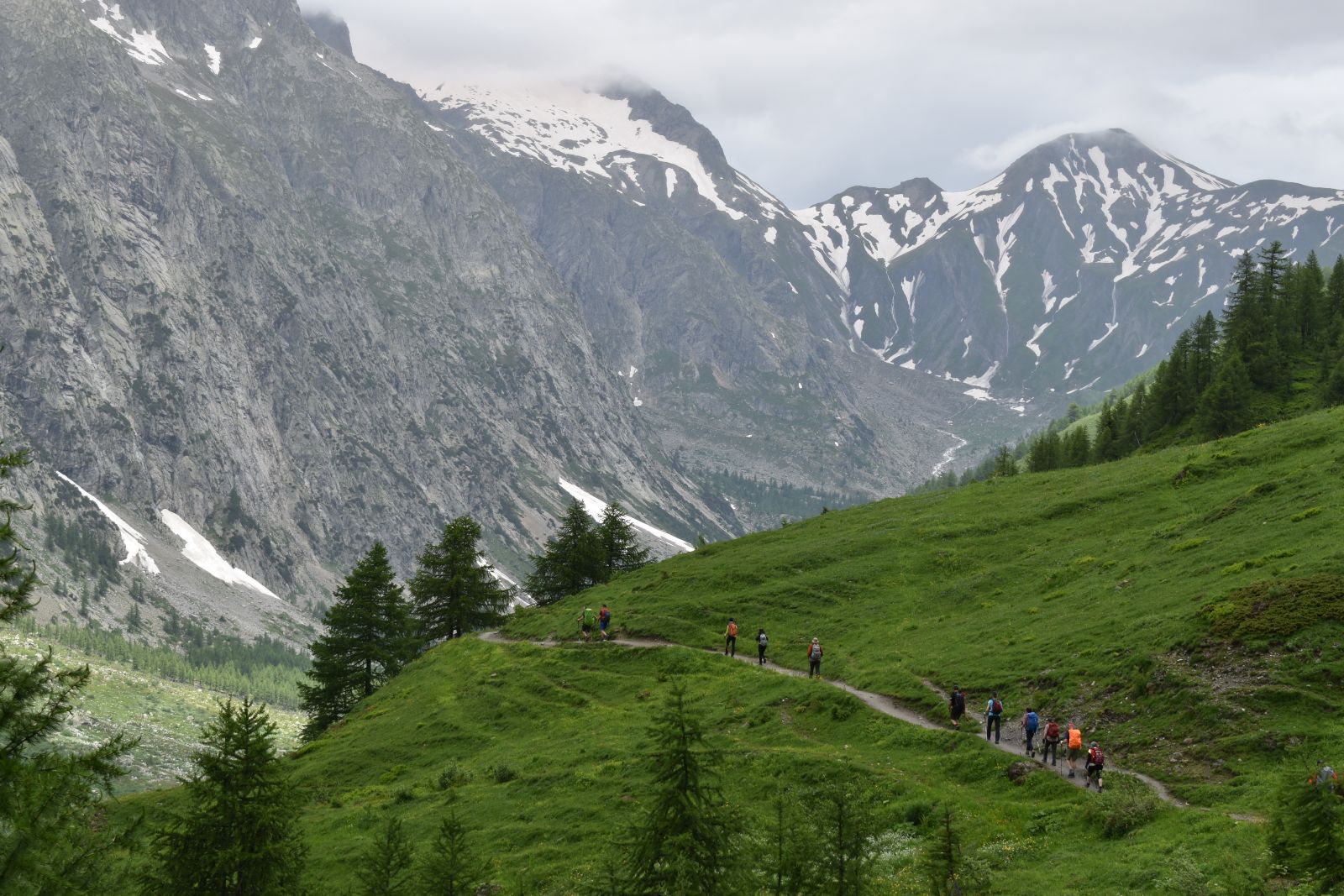
Tour Du Mont Blanc Route
The Tour du Mont Blanc hike does not travel to the summit of Mt. Blanc. (That’s an adventure for climbers with considerable mountaineering experience.) Instead, the TMB route circles the Mont Blanc massif, which straddles the borders of Italy, Switzerland, and France.

The official TMB circuit is broken into 11 stages. A typical stage includes one or two heart-pounding slogs up to a scenic col (a mountain pass or saddle) followed by knee-straining descents down to verdant valleys.
Traditionally, hikers start and end the trek at Le Houches, France, hiking the loop counter-clockwise over 10 to 12 days. However, you can hike the TMB more aggressively, or more leisurely, based on your experience level, fitness, and available vacation time.
Difficulty
Most hikers find the Tour du Mont Blanc physically challenging.
The most difficult part is the elevation gain. If you hike the TMB in its traditional stages, the average hiking day includes 3,000-4,000 feet of ups and downs. That’s a lot for the average hiker – and a ton of vertical for inexperienced hikers and anyone with balky knees.

At the same time, most seasoned multi-day hikers consider the TMB moderately difficult. In season, this is not a technical trail. It’s also more accessible than many multi-day treks because you’re never more than a few miles from food, water, lodging, and public transportation.
If you’re reasonably fit and train for the TMB, you can probably pull it off. For every travel vlogger with a video about quitting the TMB, there are thousands of travelers – from older kids to 80-year-old grandmothers – who complete the trek each year. And most feel a sense of accomplishment when they do.

Navigation
The Tour du Mont Blanc is easy to navigate. The route is more or less a loop marked by yellow arrows and detailed signs that point toward cols, towns, and (most) accommodations with estimated walking times.

Plus, the route is well traveled. You’ll almost always be following a line of hikers, which makes it easy to stay on trail.
Most hikers download a map of the TMB to their phones prior to the hike or use a navigation app (which requires international data) as a backup. We got off track once— when a sign had been knocked over and buried in the snow — and paused twice when arrows pointed toward two plausible paths. In these cases, it was nice to have a downloaded map as a backup.
Otherwise, we simply followed the obvious signs, keeping that giant mountain on our left as we walked counterclockwise through an alpine wonderland.
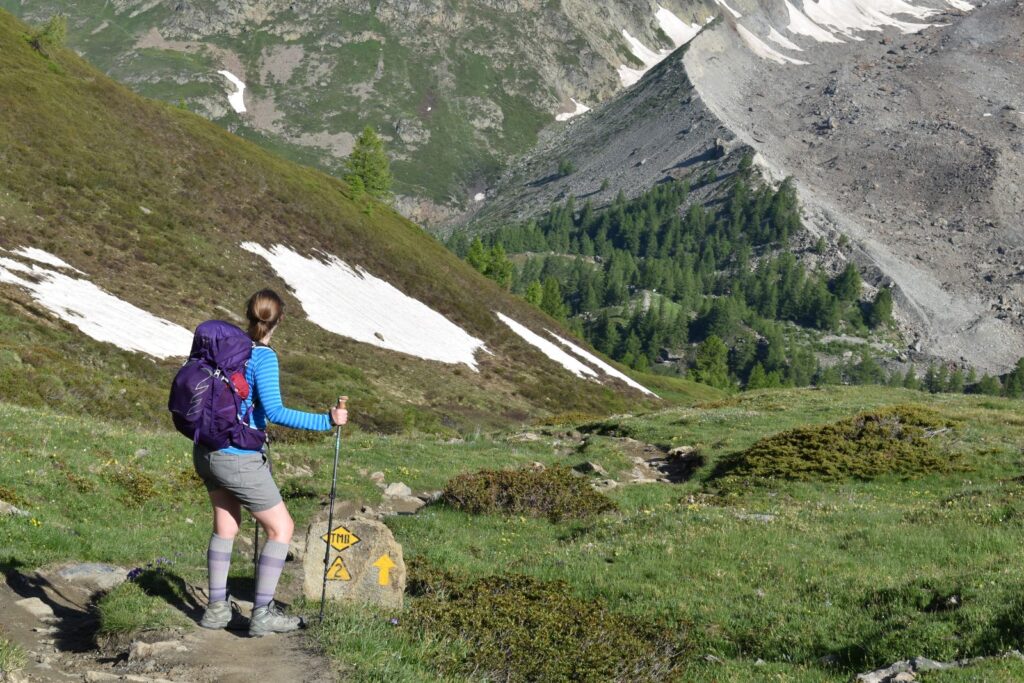
When to Hike the TMB
The Tour du Mont Blanc hiking season generally starts in late June and ends in mid-September. We say “generally” because dates vary each year due to winter snowpack, spring thaws, and seasonal weather fluctuations.
- Late June is a high-risk, high-reward time to book your Tour du Mont Blanc hike because late snowmelt can make high-elevation sections of the TMB hazardous or impassable. Plus, some services don’t open until early July, eliminating some public transportation hacks. That being said, late June also means fewer crowds and booking hassles. We began our TMB hike on June 25 (the earliest date outfitters consider booking) and enjoyed a safe trip – though we had to skip some high-route variants due to snow.
- July and August are peak season for the TMB. Hikers can enjoy warmer weather and full lodging, restaurant, and transportation options. Of course, mid-summer also means more crowds and more competition for rooms. (Pro Tip: Avoid scheduling your TMB hike during the famous UTMB race at the end of August.) Even though it can snow in the Alps in mid-summer, this is the safest time of year to book the TMB.
- Early September – after the summer peak – can be a great time to hike the TMB with potentially good weather, early fall colors, and fewer crowds. However, services along the route will dwindle before shutting down completely around September 15-20. You also assume more risk for colder, less predictable weather.
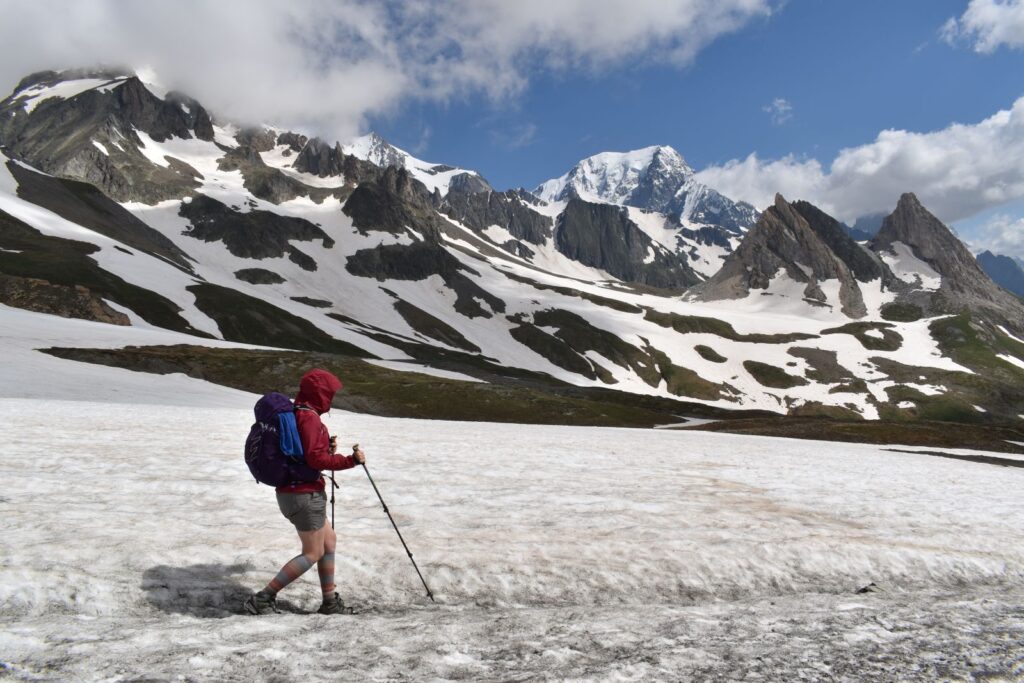
Choose Your Own Adventure
Since the Tour du Mont Blanc never strays too far from civilization, you can tackle it as a hut-to-hut hike, a backpacking trip, or even a glamping holiday with nights in spas, yurts, resorts, and 3-star hotels.
Hike your own hike. There’s no right way – or wrong way – to hike the Tour du Mont Blanc.
Hut-to-Hut Hiking the Tour Du Mont Blanc
That being said, the Tour du Mont Blanc is a classic hut-to-hut trek. You can day hike from one night’s lodging to your next night’s lodging while carrying only a daypack. This is the most popular way to hike the TMB.
Wearing a lighter pack makes the hike physically easier, and many travelers prefer ending each day with a shower, drinks, a hot meal, and a real bed.
Day hikers can choose from several types of lodging (not only huts):
- Rifugios are basic mountain lodges/cabins, usually located at high elevation with scenic views. Refuges have dorm-style bunk beds (and sometimes a few private rooms), shared toilets, showers. Most serve communal dinners and breakfasts.
- Auberges: small inns or chalets (usually family run) with private rooms. Most are located in small villages down in the valleys and include a communal dinner and breakfast.
- Hotels: 1-star to 3-star options are available in larger towns, especially the Chamonix (FR) valley and Courmayeur (IT). Meals may or may not be included in your stay.
- Resorts: splurge on spas or luxury hotels in ski villages Chamonix and Courmayeur.
You can book whatever fits your preferences, route, and budget. We recommend spending at least one night at a rifugio, however – to experience the comraderie, food, and views at these rustic mountain escapes.
We prioritized private rooms and good food for our Tour du Mont Blanc hike. Our favorite accommodations were Heliopic Spa in Chamonix, Chalet-Hotel Gai Soleil (Les Contamines), Cabane du Combal (Italy), Hotel Bouton d’Or (Courmayeur), Rifugio Bonatti (Italy), and Hotel Alpina (Lac Champex, Switzerland).
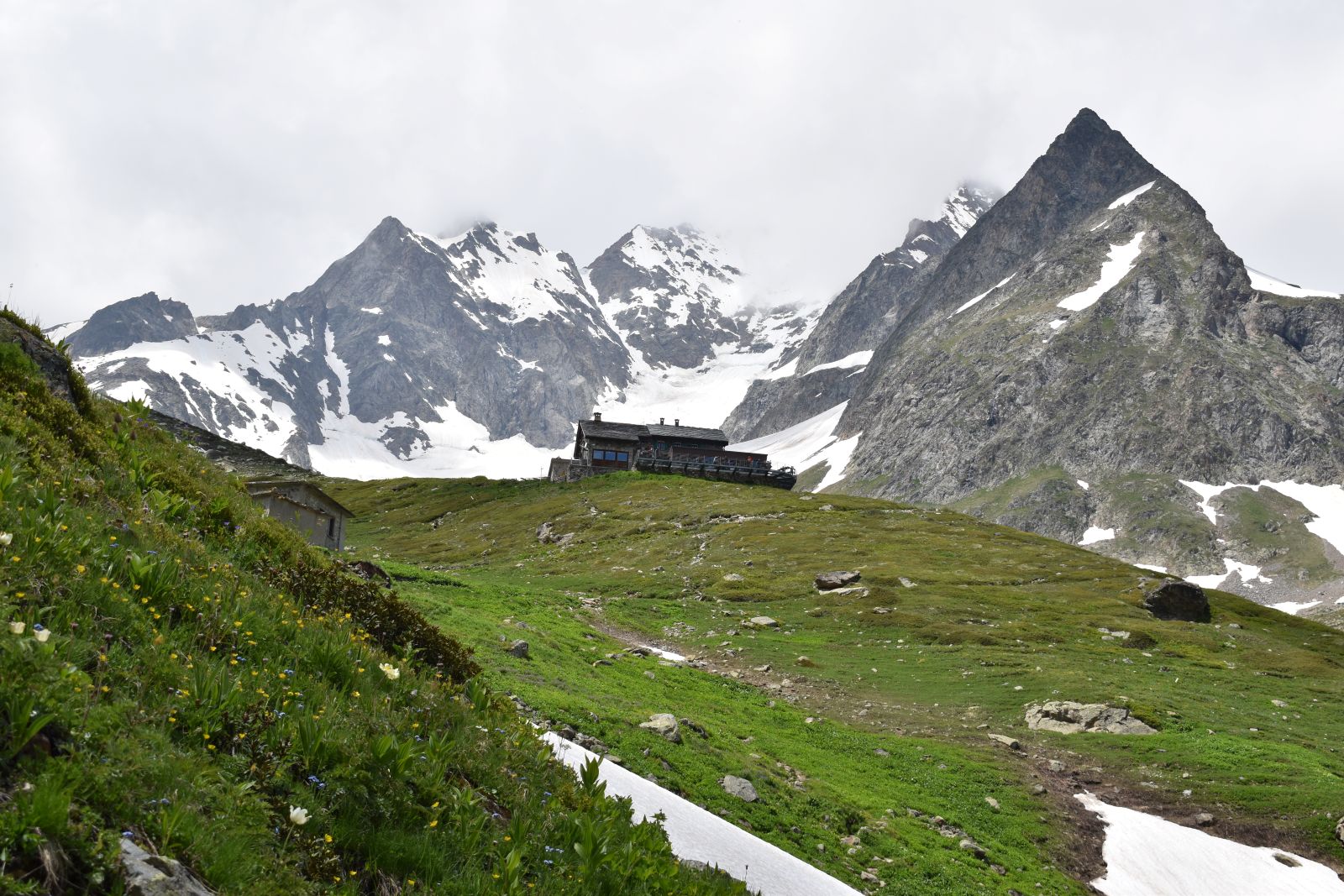
Luggage Transfers
Hut-to-Hut hikers also have the option of luggage transfers. At most (not all) accommodations, a luggage transfer service can pick up heavier bags in the morning and transport them to your next accommodation while you hike the TMB with a lighter day pack.
This option lets you carry even less weight during the day — which makes the Tour’s steep ascents and descents easier. Luggage transfers also let you enjoy more clean clothes, toiletries, and creature comforts (most nights).
Here are the luggage transfer services we recommend on the TMB:
For us, this added luxury was too expensive. But if you’re the type who overpacks, struggles with steep trails, or loves fresh outfits, luggage transfers will be money well spent.
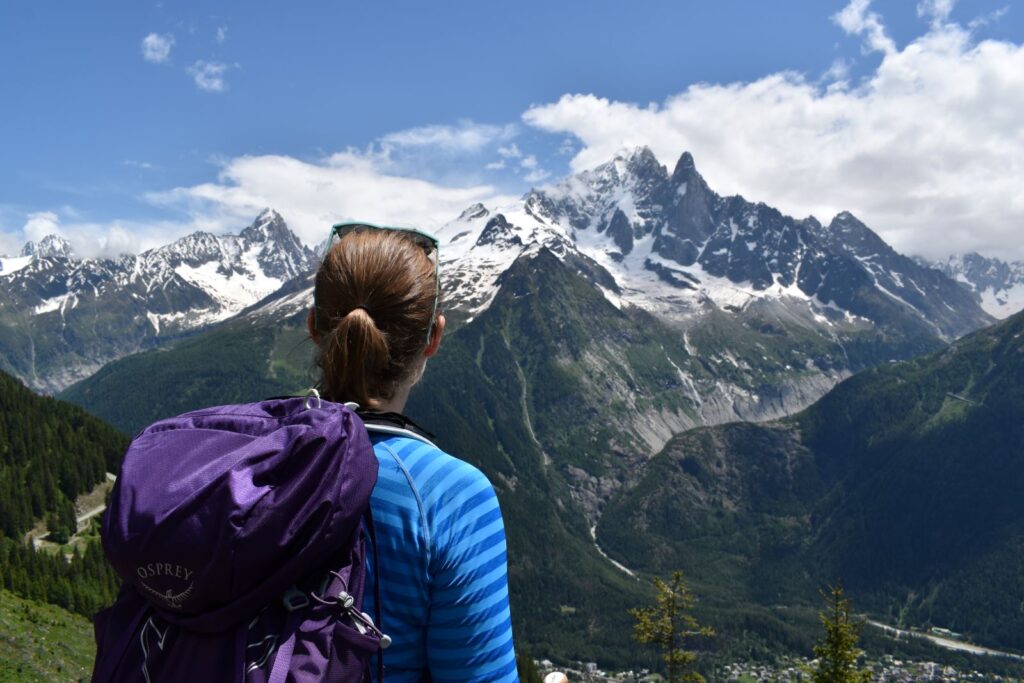
Backpacking the Tour Du Mont Blanc
If you prefer a more natural – or less expensive – adventure, you can also backpack the Tour du Mont Blanc. Backpackers enjoy a mix of wild camping and formal campgrounds, sleeping outdoors in lieu of the snores and smells of hiker dorms (rifugios) and the expense of private rooms. Plus, campsites are generally first-come, first-served, so backpackers can skip the stress of self-booking a hut-to-hut trip or choosing a guide service.
Backpackers also enjoy more schedule flexibility on the Tour du Mont Blanc. While hut-to-hut hikers are locked into pre-booked rooms and meal reservations, backpackers can change their schedule on the fly to avoid thunderstorms, time scenic high routes for when they’re not clouded over, rest a sore knee, and join (or avoid) groups of hikers they meet on the trail.
As a bonus, backpackers can also enjoy some spoils at rifugios, such as hot meals, sweets, coffees, beer, wine, and sometimes showers.
The biggest trade-off is backpacking puts more weight on your back. This makes the TMB’s steep sections more difficult for backpackers than day hikers.
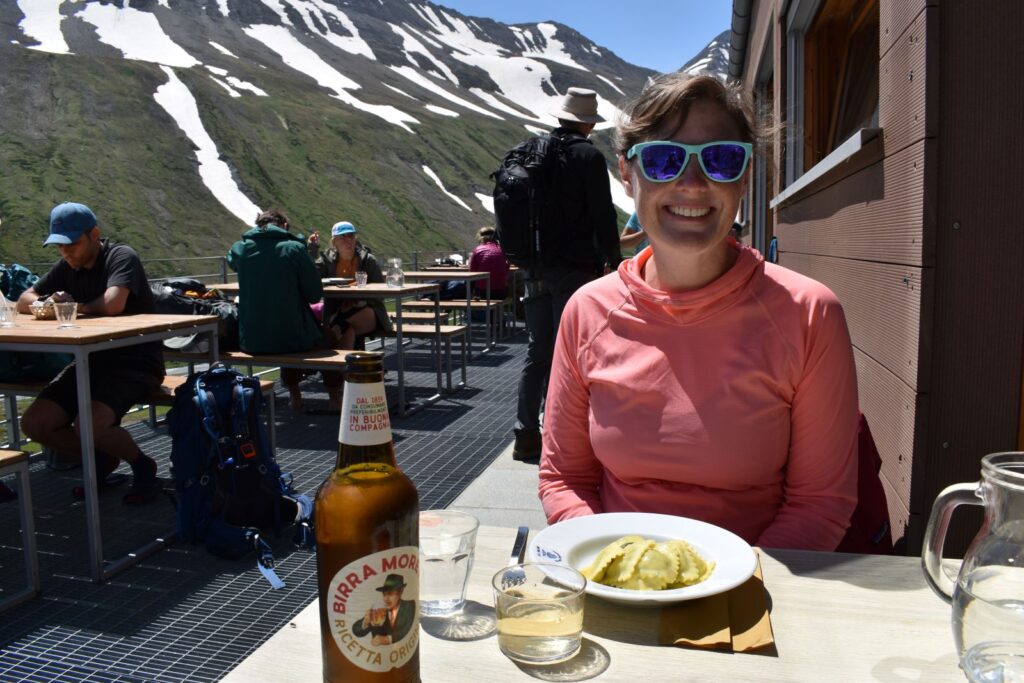
Backpacking Rules & Regulations
The other complication is that France, Italy, and Switzerland each have different backpacking regulations. Here’s the Cliffs Notes version:
- France: Wild camping is permitted for one night (outside of nature reserves) as long as you set up camp after 7:00 p.m. and leave a clean campsite by 9:00 a.m.
- Italy: Wild camping is only permitted above 2,500 meters, which means TMB backpackers are mostly limited to designated campgrounds at lower elevations.
- Switzerland: Wild camping is illegal. TMB backpackers must stay in official campgrounds or (in limited cases) get permission to camp outside a refuge.
Red tape aside, backpackers can find camping all along the route. Plus, it’s usually easy to access food and potable water (see notes below) – which cuts down on pack weight. Just do your route homework in advance to plot your food stops and maximize your wild camping opportunities.
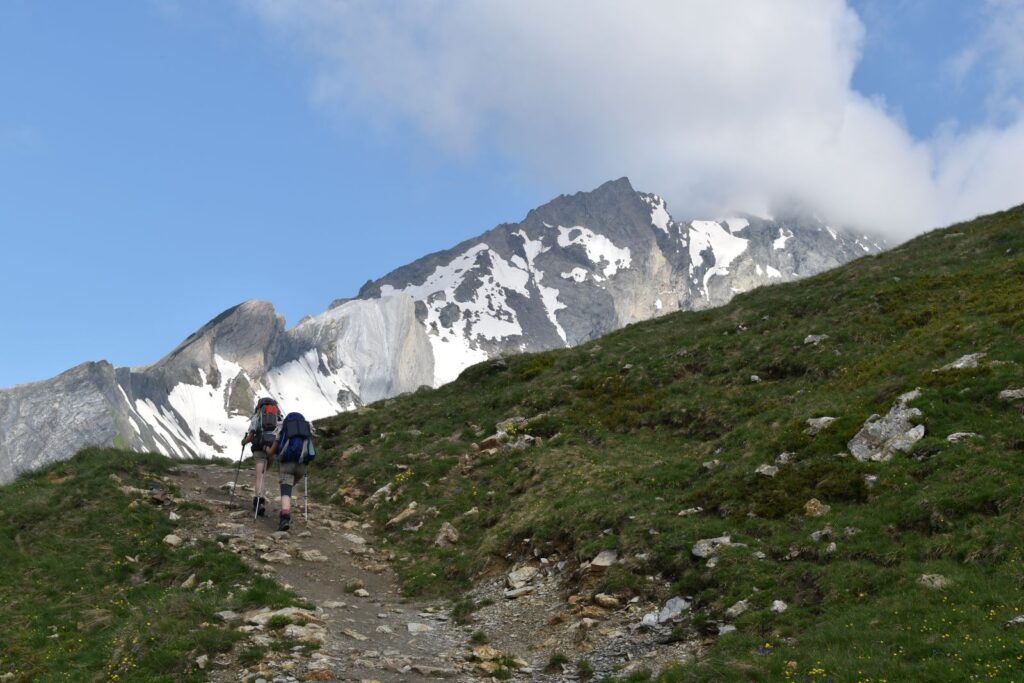
Self-Booking the Tour Du Mont Blanc
Hut-to-hut hikers have one more decision to make: self-booking their own TMB holiday or hiring a professional outfitter for a guided or self-guided hike.
Self-booking the TMB may be economical, but it’s not for the faint of heart (which is why we’ve published this lengthy guide). Even if you’re well prepared and start early, it takes weeks and often months to book your beds. Why?
- Some accommodations accept reservations as early as October (for the following summer) while others won’t begin booking until December, January, or even April. This requires waiting and some gambling.
- Individual businesses have idiosyncratic ways of reserving rooms and confirming payments. Expect a mix of international phone calls, emails, WhatsApp messages, online contact forms, and varied payment methods – not all of which are secure.
- Popular spots sell out quickly, especially for July and August itineraries. This can leave you scrambling for 2nd, 3rd, or 10th choices – which may require public transportation.

Self-booking can be a stressful, time-consuming process, especially if you’re anxious, impatient, or limited on time. That being said, you can save significant money by booking your own trip. Plus, you have full control over your rooms, meals, route, and hiking pace.
We self-booked our 2024 TMB trip — and weirdly enjoyed the logistical challenges (in the end). But we don’t blame you if you want to hire an outfitter to do most of the dirty work for you!
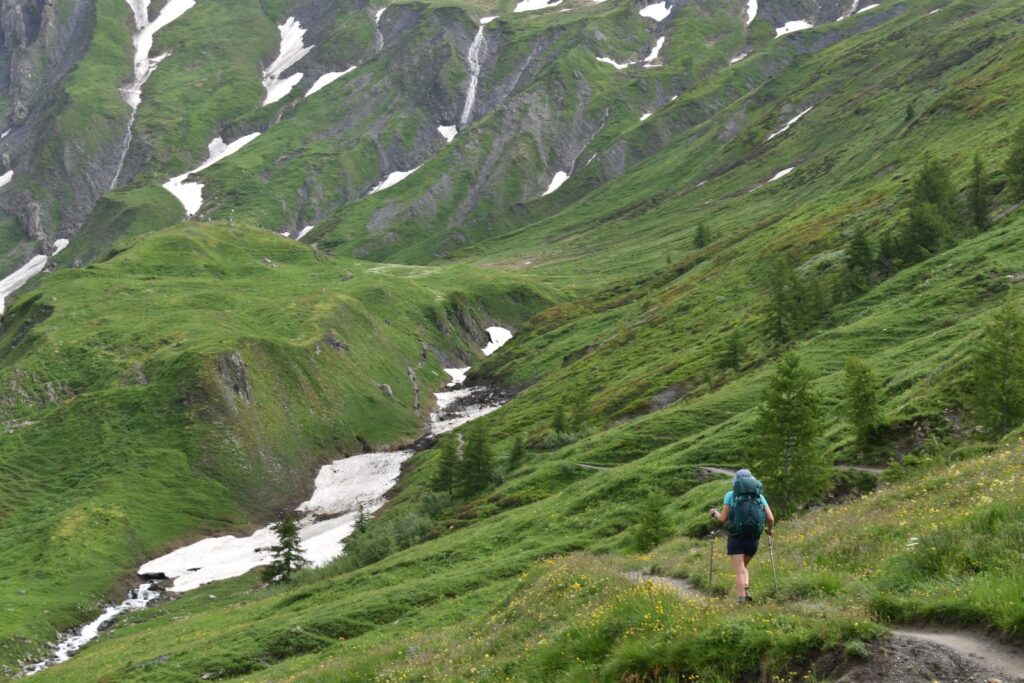
Booking the TMB Through a Tour Company
Tour companies can also plan your TMB itinerary and book your accommodations based on your availability, budget, and preferences. Most tour companies offer both guided trips and self-guided trips:
Guided trips: A guide will book your TMB meals and lodging in advance and then lead your group around Mt Blanc. A guided trip may be good for inexperienced hikers and solo travelers. Just expect to pay a premium for a guided TMB hike.
Self-Guided trips: A tour company will book your TMP trip – saving you months of logistical labor. Then you hike that itinerary independently at your own pace. Self-guided trips make sense if you’re short on time, hike slower or faster than average, or struggle with online research, decisions, cross-cultural communication, or patience.
Everyone we met on the TMB who booked through an outfitter had great things to say about their tour companies and professional guides. We recommend comparing packages and prices for these reputable outfitters: Mac’s Adventure, Alpine Adventures, Altitude, Pygmy Elephant (self-guided only), and 57 Hours.

Planning your Tour Du Mont Blanc Itinerary
If you’re booking your own Tour du Mont Blanc trip, the first step is planning your route. To wrap your mind around the trail, we recommend watching a few YouTube videos to picture the trail and the available lodging options. We also highly recommend buying one of these two guidebooks:
- Kev Reynolds’ Trekking the Tour du Mont Blanc is the classic guide (last updated in 2024)
- Some travelers prefer Andrew McCluggage’s Tour du Mont Blanc (last updated 2022)
Either of these guide books will explain the 11 stages, their variants, and accommodation options on or near the trail. The somewhat official TMB site also has a route-planning tool, which includes many (but not all) lodging options with distances and approximate hiking times in between options.
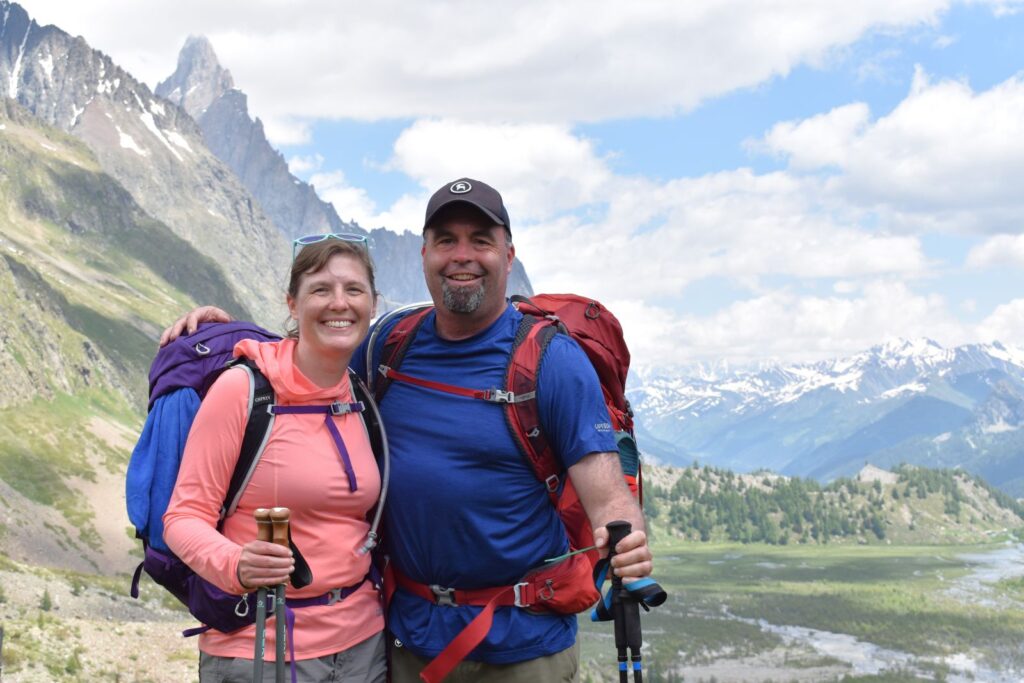
Clockwise vs. Counter-Clockwise
The Tour du Mont Blanc was designed to be hiked counter-clockwise – which is how most people do it. However, there’s no rule against hiking the route clockwise.
Some people hike the TMB clockwise to enjoy fewer crowds early in the morning. For better or worse, clockwise walkers will get to know fewer people on the TMB by hiking against the stream. Others hike it “backwards” to get around sold out accommodations on a counter-clockwise itinerary.
One downside of the clockwise route is “the ladder section” at stage 10. It’s more difficult to climb down those iron ladders (clockwise route) than it is to climb up them (counter-clockwise route). Keep that in mind if you’re afraid of heights or anxious about those ladders.
Otherwise, there’s no big difference in the views either way.
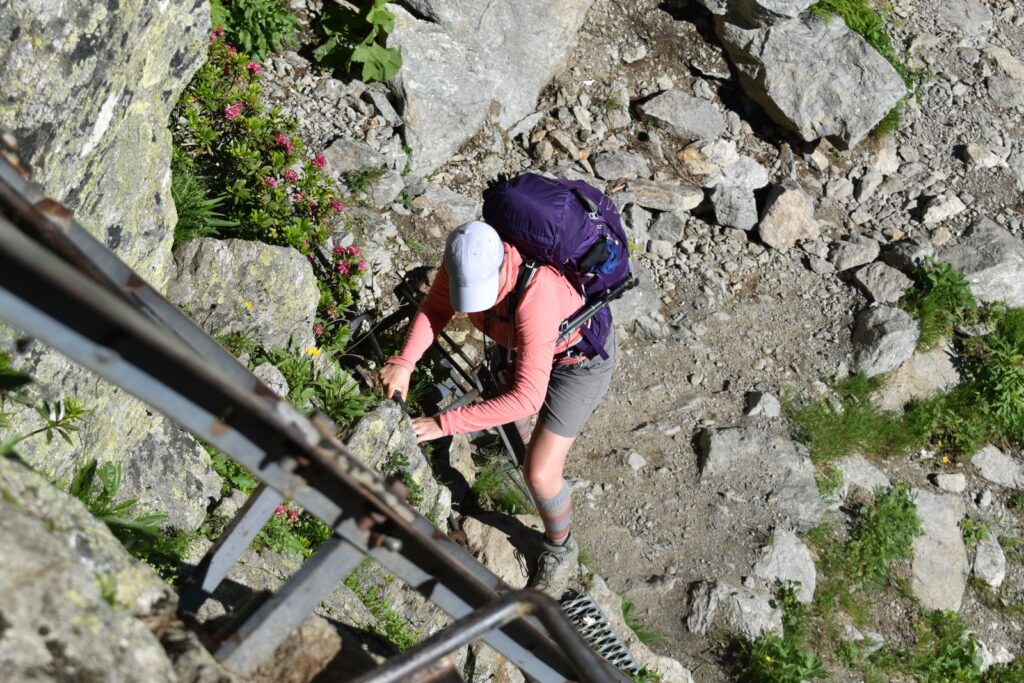
Where to Start the TMB
The traditional starting point (and ending point) of the TMB is Le Houche, France — a small village a few kilometers outside of Chamonix. Le Houche is quick and easy to reach by bus from the Chamonix Sud Bus Station.
However, you can start your Tour anywhere on the trail since the route is a loop.
For example, some counter-clockwise hikers actually start from Chamonix with Stage 10 or 11. This tweak lets you begin with a super-scenic section or avoid potential logistical challenges at the end of the route (because there are fewer beds available at Stages 10-11). That said, you might want to avoid starting off your trip with stage 11’s knee-killing descent to Le Houche (or skip it via the Brevent/Plan Praz cable car).
If you’re hiking the TMB clockwise, we recommend starting at Lac Champex, Switzerland or Courmayeur, Italy. Starting from Lac Champex or Courmayeur gives you a more manageable beginning (tip: take the Dolonne cable car up from Courmayeur) and a more memorable ending than beginning/ending at Le Houche.
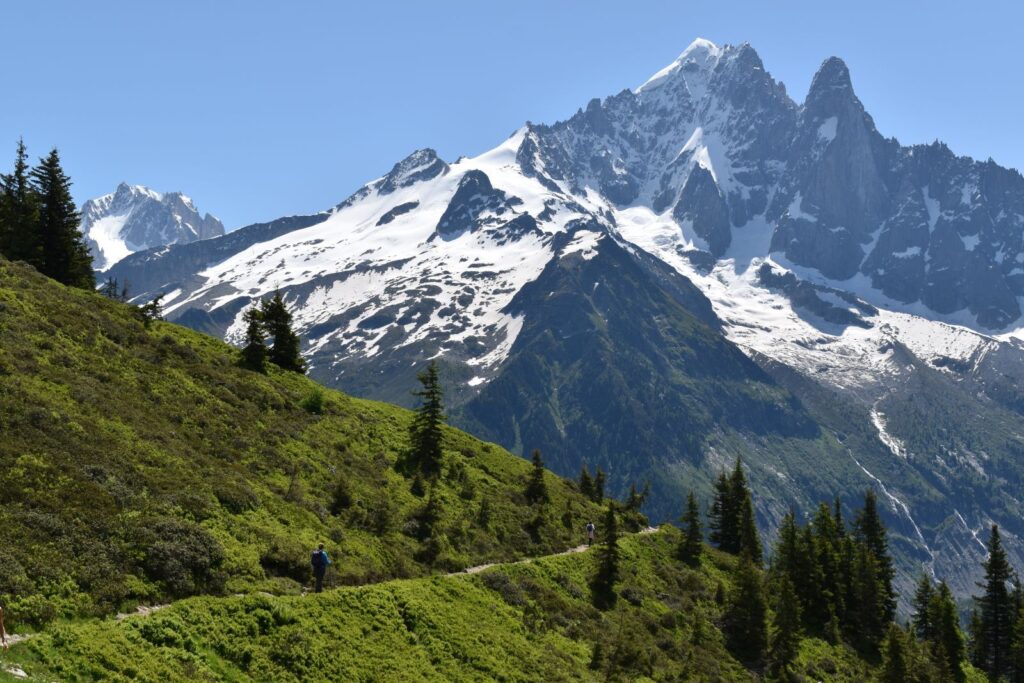
How to Get to Your Starting Point
Most international travelers fly into Geneva, Switzerland and then take a bus, train, or shuttle service to Chamonix, France (or an alternate starting point – see above).
Shuttle buses are the quickest option (since there’s no direct train). AlpyBus is an affordable and reliable option to get from Geneva to Chamonix. Mountain Drop-Offs is another popular transfer service. For more transfer options — including private and shared shuttles — see this complete list of shuttle providers.
You should book your airport transfers in advance – once you’ve purchased your flights.

Daily Mileage & Elevation Gain
When planning your itinerary, you need to estimate how much hiking you can handle (and enjoy) each day. If you are not a hardcore hiker, you probably shouldn’t stray far from the classic, 11-stage itinerary – ideally with an added off day or two. (Chamonix, Courmayeur, and Lac Champex are the best spots to spend a rest day.)
If you are an experienced hiker or backpacker who knows how much daily distance and vertical you can handle, you can divvy up your days accordingly, using the guidebooks and tools above. Just don’t underestimate the TMB’s ups and downs – they slow most hikers down.
Smart hikers try to clear the highest passes before noon to reduce their risk of meeting an afternoon thunderstorm high in the mountains. Also keep in mind that many rifugios and auberges require you to arrive no later than 5:30 p.m. to guarantee your 7:00 dinner spot (or your seat may be sold to a backpacker or walk-in).
Finally, remember that you can shorten stages — or even skip stages — using public transportation and choose from many variant routes to customize your TMB itinerary.

Shortcuts & Public Transportation Hacks
Thanks to Europe’s excellent public transportation, you can build short cuts into your Tour du Mont Blanc hike via buses, cable cars, chair lifts, etc. These public transportation hacks can be especially helpful to
- Make your days shorter and easier
- Dodge dangerous thunderstorms or snowed out high routes
- Give sick, sore, or tired hikers a break
- Access off-route accommodations (when on-trail rooms are sold out) and more bougie hotels
- Focus on TMB highlights, especially if you have limited vacation time
On our trip, for example, we took a cable car to skip a steep climb with limited views, caught a shuttle bus to shave off three miles of road walking in the rain, and descended another cable car to bypass a high route that was closed due to snow.
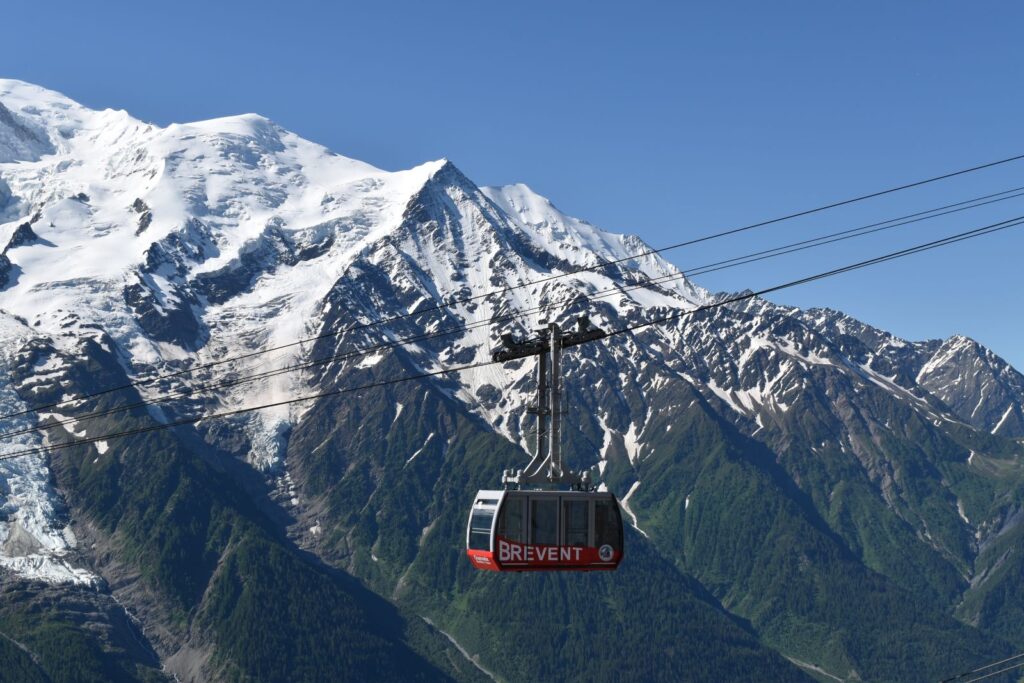
Here are some of the most popular public transportation shortcuts on the Tour du Mont Blanc:
- Stage 1: Take the Bellevue telepherique (cable car) up from Les Houches to shave off 2500 ft (800m) of climbing through a less scenic section
- Stage 3: Shuttle bus from Les Chapieux to Village des Glacier or des Mottets refuge
- Stage 4: Skip an ugly, knee-shredding descent to Courmayeur with the Dolonne cable car
- Stage 6: Shorten a long day with a bus from Ferret to La Fouly
- Stage 7: Skip this easier but less scenic stage with the bus to Champex-Lac
- Stage 11: Skip a beautiful but brutal climb (clockwise route) or descent (counter-clockwise route) with the Plan Praz cable car
Keep in mind that some of these shortcuts are only available during peak season. For more options to shorten your route, check out these TMB public transportation recommendations.
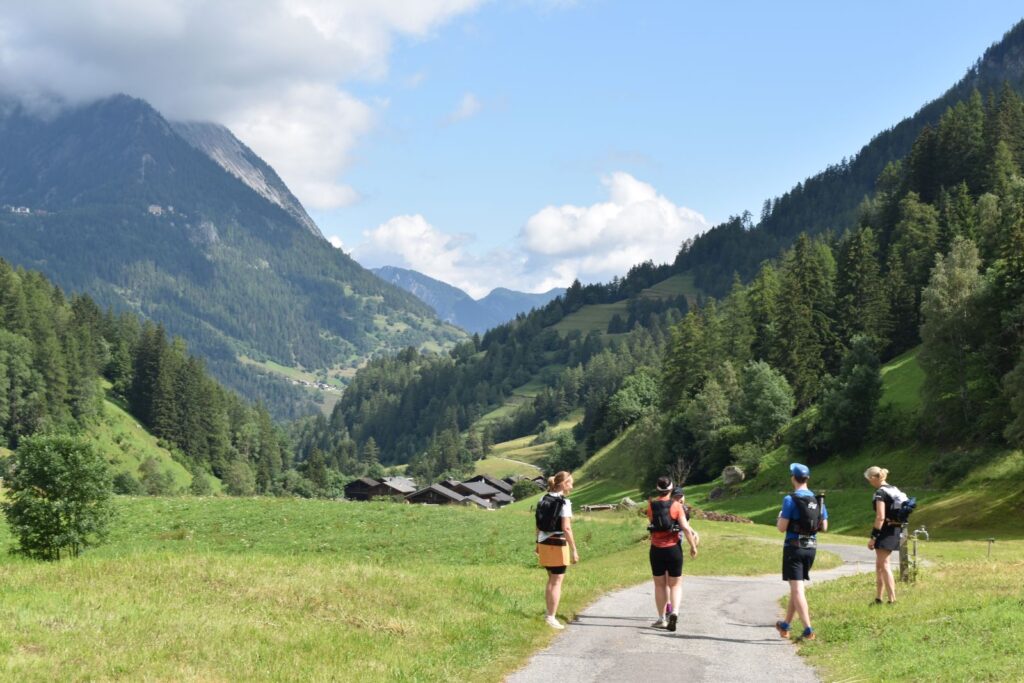
Tour Du Mont Blanc Variants
On the flip side, you can extend your TMB adventure by adding variants to the official route. Variants are alternative legs of the TMB – most of which are more challenging high routes than the official TMB stages.
The main draws of venturing off the main TMB trail are fewer crowds and more panoramic views. Plus, some hikers prefer the physical challenge of steeper climbs and more mileage for some type 2 fun.
Here’s a list of the most popular variants on the Tour du Mont Blanc:
- Stage 1: Add the Col de Tricot variant (in clear weather) for more alpine views
- Stage 2: Add the Col du Fours variant as an optional high route (especially if staying at Refuge des Mottets)
- Stage 5: take the Mont de le Saxe variant from Rifugio Bertone to Rifugio Bonatti for some of the best views of the trip, animal sightings, and fewer crowds
- Stage 8: take the Fenêtre d’Arpette variant for stunning views of the Trient glacier —and the TMB’s most masochistic ascent/descent (strong hikers only in good weather)
- Stage 10: Use the Col des Montets variant to bypass the popular “ladder section” if those ladders freak you out. (We loved the ladder section).
- Stage 10: Take the Lac des Chéserys and Lac Blanc variant to enjoy alpine lakes and stunning vistas of Mount Blanc.
If you’re an ambitious hiker (like us), you absolutely should build some variants into your TMB trip (if the weather allows for them).
Just remember: high routes usually mean more exposure – to storms, lightning, and (in a few cases) dangerous falls – which means many variants are weather-dependent. Late spring thaws, thunderstorms, or summer snows can make some variants risky or impassable. Simple clouds can sabotage the views from those optional Cols and scenic ridgelines, too.
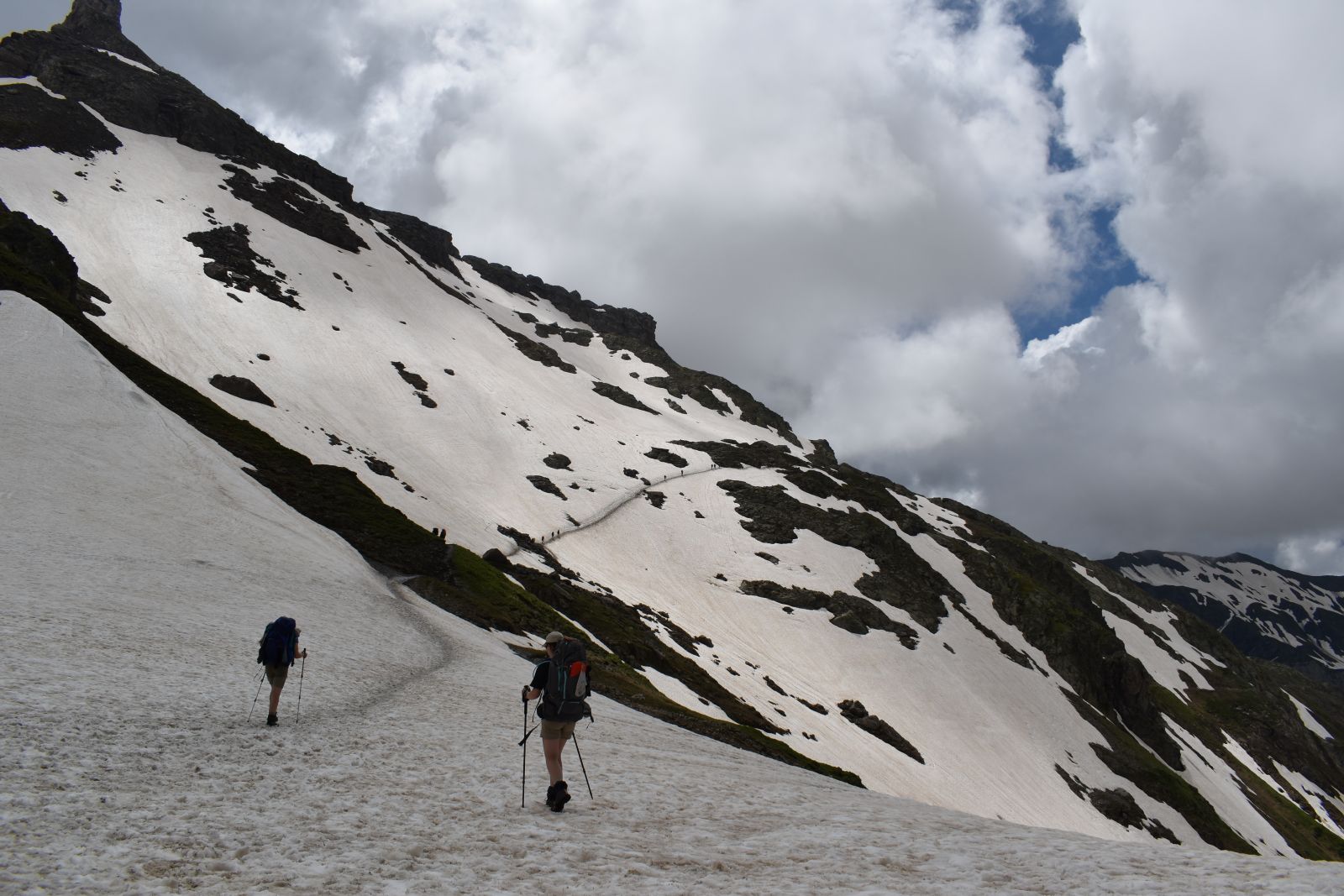
When to Book Your Tour Du Mont Blanc Trip
If you choose to book your own TMB adventure, you need to plan your trip well in advance.
Savvy travelers plot their preferred TMB itinerary in September and begin booking their lodging in October for the following summer. That’s the best way to reserve on-route rooms, get into most of your preferred accommodations, and potentially score a rare private room in a rifugio.
Keep in mind that self-booking typically takes weeks or months to finish. We booked our first rooms the first week of October and booked our last bed on November 17 (which is actually quicker than average).
It’s possible to plan your trip six months out – or even later, due to late cancellations. In fact, some accommodations don’t even accept reservations until December, January, or even April. However, many rifugios and hot spots sell out by January, especially for peak season trips.
For last minute TMB trips, we recommend backpacking over hut-to-hut hiking.

How to Book Your Tour Du Mont Blanc Trip
Backpackers don’t need to reserve campsites in advance. Day hikers need to reserve every bed/room individually for their hut-to-hut itinerary.
You can book many (but not all) rifugios through this association’s booking portal. This online system starts accepting reservations around mid-October for the following summer.
Any accommodation not affiliated with the site above — that is, most hotels, auberges, inns, chalets, resorts, and privately owned rifugios — require you to contact them directly to reserve a room.

Browse each business’s website for instructions on how and when to contact them. Expect a mix of international phone calls, online contact forms, email exchanges, WhatsApp messages, etc. Most businesses accommodate English language, but Google Translate can be a useful tool to communicate in French or Italian as needed.
Food & Drink
Most of the rifugios and inns on the TMB include food options that you reserve in advance at the time of your booking.
- Half-Board includes your bed (or private room) plus communal dinner and breakfast.
- Full-Board includes your bed plus dinner, breakfast, and a sack lunch to go
For many people, the food is a highlight of the TMB. In fact, many people actually gain weight while hiking 100+ miles, thanks to all the food and drinks along the route!
Most rifugios, auberges, and inns serve hearty, multi-course meals at night. Think soup and/or salad with bread, a main course, and a desert – all washed down with French or Italian wines. Breakfasts tend to be typical European continental spreads: heavy on breads, cereals, yogurt, and cheese and lighter on proteins.
In our experience, the quality of food tended to be better in the smaller inns and auberges than the rifugios.
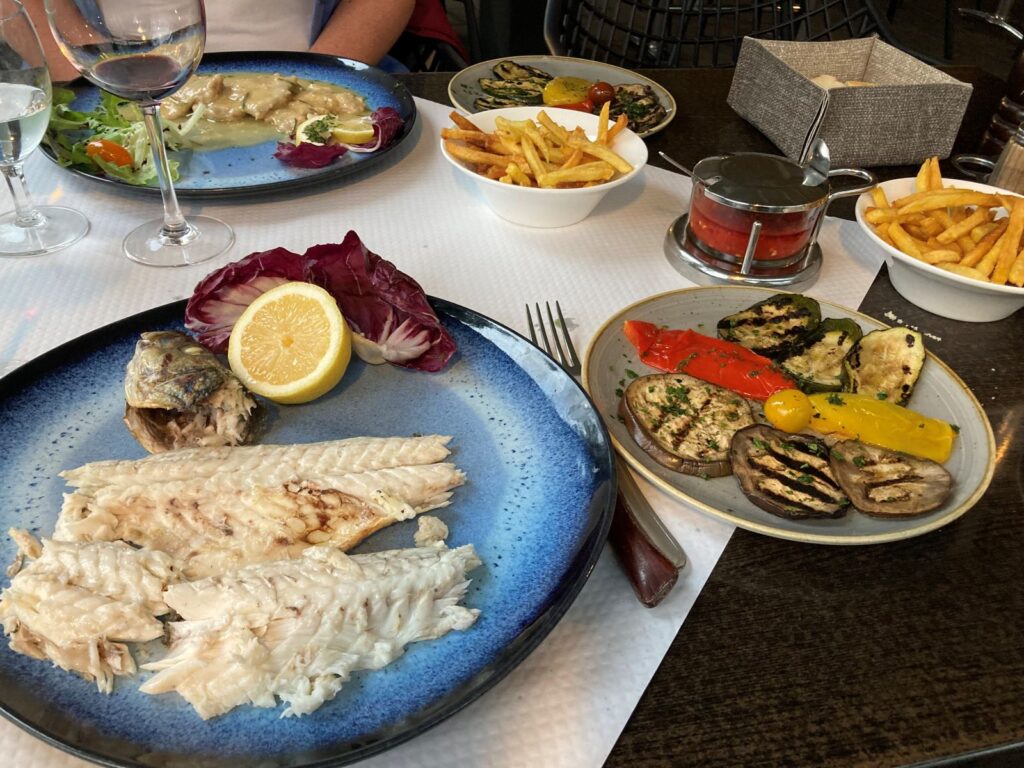
Many TMB stops now accommodate vegetarian and (to a lesser extent) vegan diets with advance notice (e.g. indicate dietary preferences when you book your room and board). Just expect more carbs than veg.
Take-away lunches (“full board”) can be convenient on the TMB, especially if you have a long hiking day ahead or a thunderstorm to race to the saddle. However, most hikers hit up rifugios, dairies, and farms along the route for coffees, omelets, pastries, farm-fresh breads and cheeses, sit-down lunches, deserts, beer, and wine. If those options appeal to you – and you’re not overly concerned about your budget – you might regret choosing a sack lunch over some of the TMB’s food stops.
Food Options for Backpackers
Yes, backpackers can also hit up refuges for food during the day and – in some cases – even buy dinner at night (contingent on availability and cancellations). However, most backpackers choose less expensive options, such as
- stopping at small supermarkets (available in Chamonix, Les Houches, Les Contamines, Courmayeur, La Fouly, Champex-Lac, and Argentière)
- packing dehydrated backpacking meals
- stopping at bakeries, delis, and farms for fresh breads, cheese, and meats for sandwiches and picnic spreads.
Like most TMB decisions, food boils down to your budget and personal preferences.

Water Along the Tour Du Mont Blanc
Potable water is readily available at rifugios, troughs, and public fountains along the route. This means you usually don’t need to carry more than 1.5 liters of water at a time – which keeps your pack lighter. The main exception is the section between Tré-le-Champ and Planpraz (Stage 10/11) – make sure to carry extra water during these stages.
Some hikers/backpackers carry a small water filter for a backup – like the Sawyer Squeeze or Katadyn BeFree – but most get by without one since treated water is so available. Any stream or natural water source would need to be filtered before drinking.
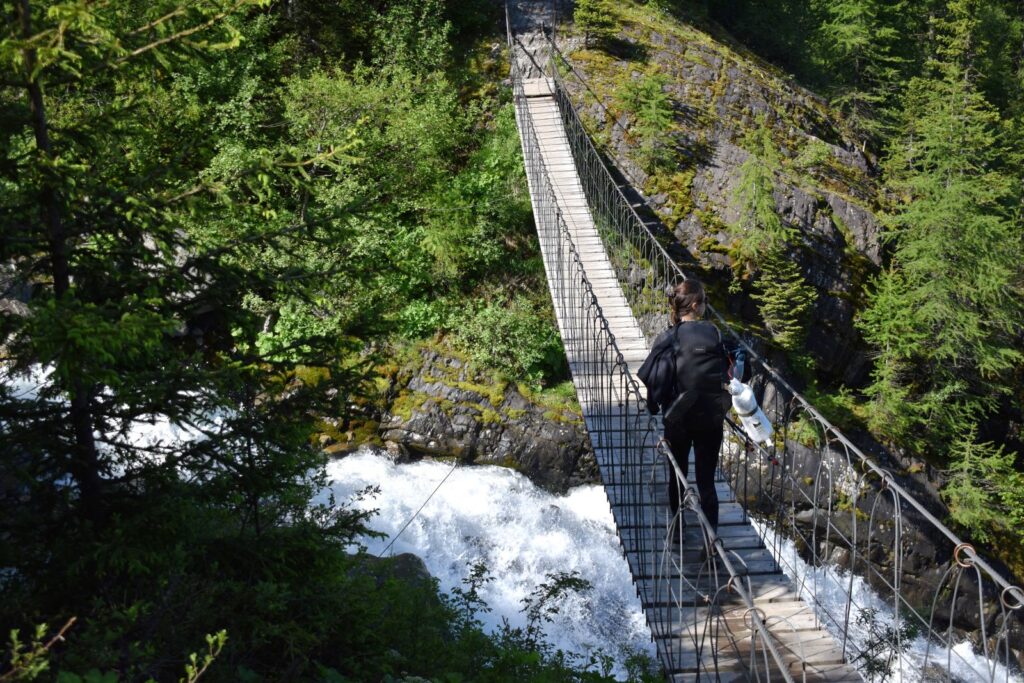
Cash vs. Credit Cards
You will need cash on the Tour du Mont Blanc because many mountain huts, refuges, and auberges do not accept credit cards. Most businesses in the larger cities DO accept credit cards.
You’ll need Euros for France and Italy. Many Swiss establishments also accept Euros, but some only accept Swiss Francs. (Make sure to check your accommodations’ policies before the trip.)
ATMs are most accessible in Chamonix (France) and Courmayeur (Italy). It’s harder to get cash in the Swiss stages, but you’ll find an ATM at La Fouly (tourism office) and Champex-Lac (next to the lake).
As a general rule, expect higher prices in Switzerland than in Italy and France.

Travel Insurance
We highly recommend purchasing travel insurance for your Tour du Mont Blanc trip to cover cancellations, illnesses, and emergencies. When choosing travel insurance, make sure to buy a plan that will cover high altitude trekking and helicopter evacuations – or risk getting stuck with a $30,000 rescue bill. (We sadly saw rescue helicopters regularly on our trip.)
We’ve used World Nomads for treks in the past. We found the rates were reasonable, the coverage met our needs, and communicating with them was easy. For our TMB trip, we used Allianz Global Assistance based on the recommendations of past TMB hikers who experienced worst-case scenarios on their trips.
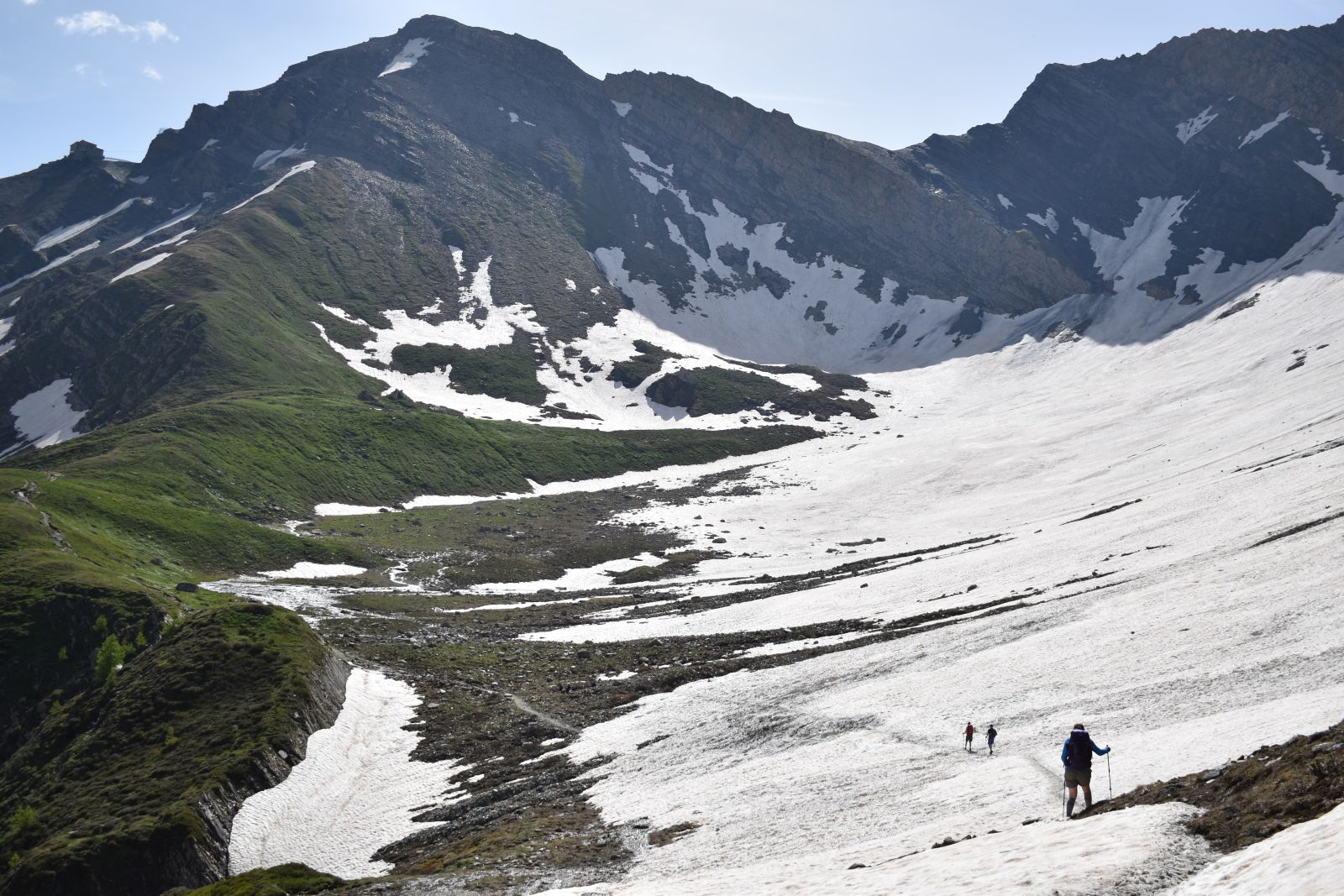
Wildlife
You won’t confuse the Tour du Mont Blanc with Yellowstone National Park. Still, you have a decent chance of spotting some wild animals along the trail. If you’re lucky, you may spy marmots, chamois, and ibex, especially at high elevations. We saw all three.
Animals pose little risk on the TMB, but you will pass through working farms and livestock grazing lands. Please leave cows alone, respect private property, and don’t give farm dogs any reason to think you’re up to no good (i.e. stay on the trail).
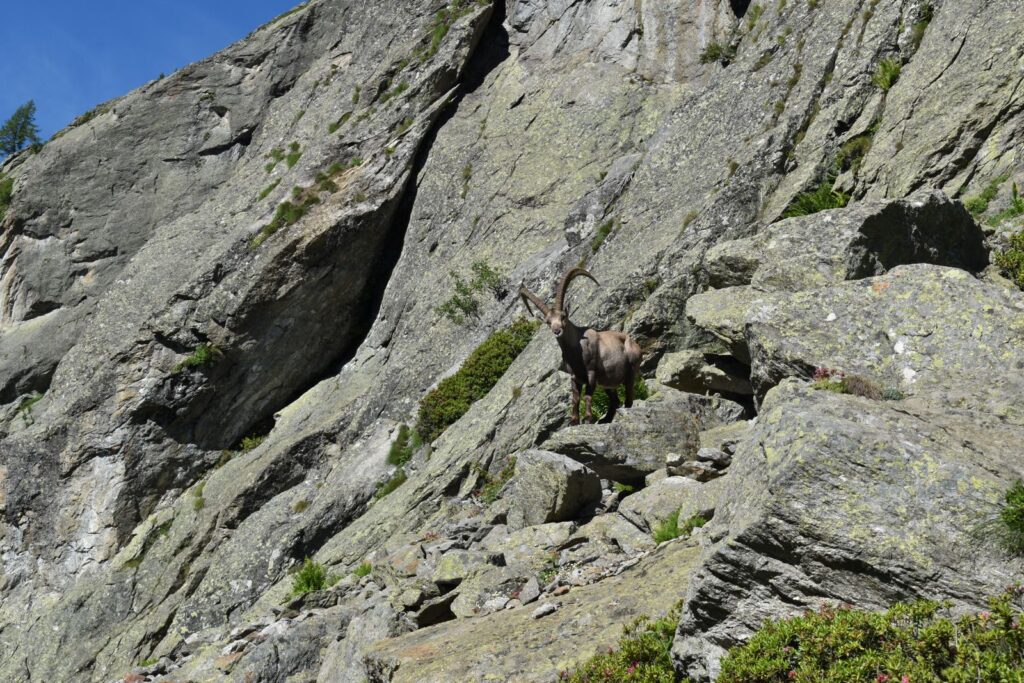
Weather
The biggest contingency to plan for on the Tour du Mont Blanc is weather. Alpine weather is no joke.
You may enjoy mild temperatures for much of your hike, especially at lower elevations. However, snow is common year-round at high elevations – even in mid-summer – and so are afternoon thunderstorms. Both can be dangerous if you encounter them on a mountain pass or exposed ridgeline.
This means you need to pack and prepare for 4-season weather and expect everything from snowstorms to sunny skies and 85 degrees F (30 C) — sometimes on the same day. Please keep this unpredictable alpine climate in mind as you decide when to tackle the TMB, where to stay on the route, and what to wear.
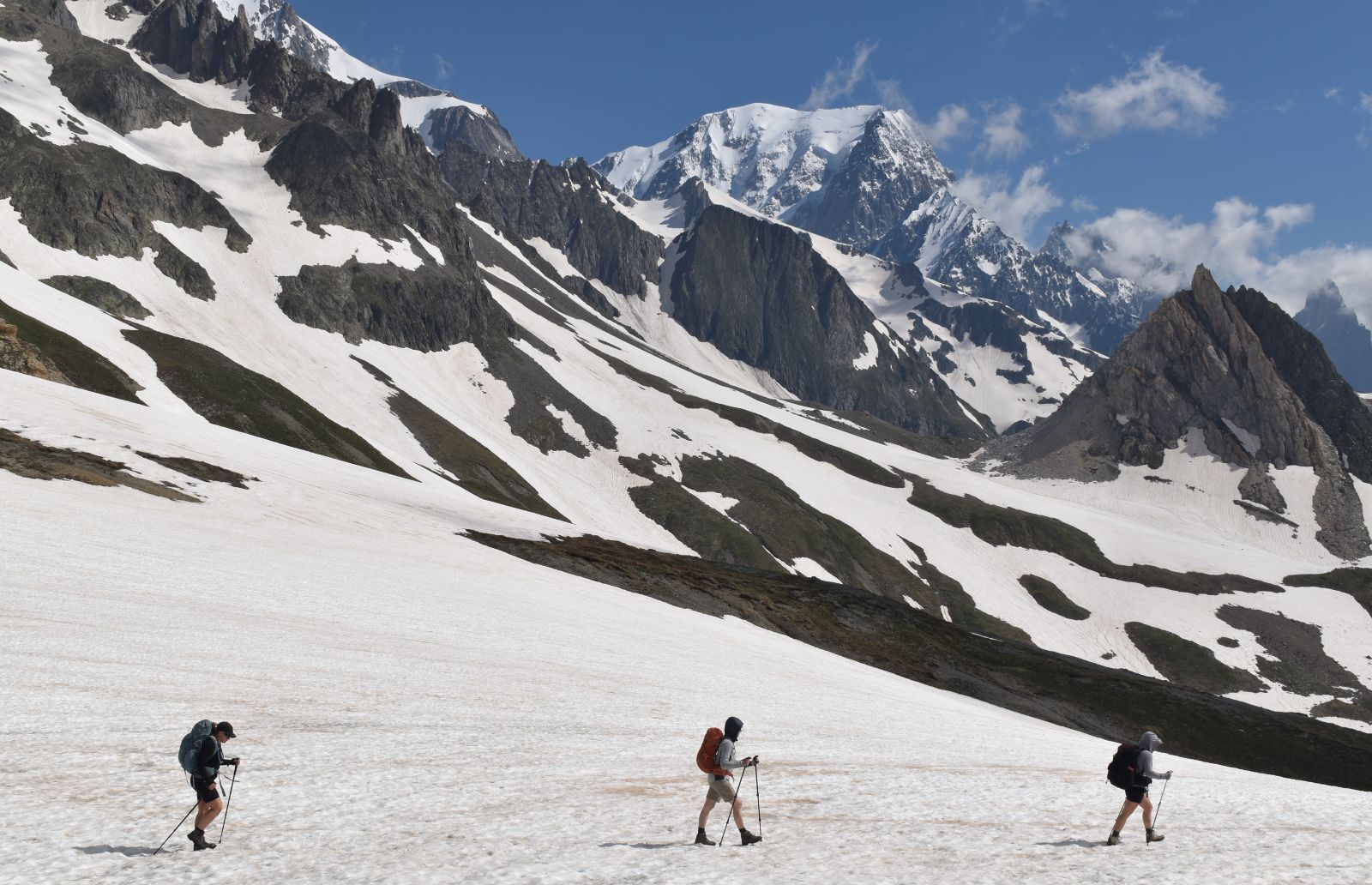
What to Pack for the Tour Du Mont Blanc
Even though the Tour du Mont Blanc is a summer hike, you need to pack for 4-season conditions because of the altitude and the Alps’ temperamental weather. You can hope for the best but need to pack for the worst: rain, snow, cold nights, and hot days.
TMB Clothing
Dressing for the Tour du Mont Blanc is all about mixing and matching layers – our layering guide explains how. Layering is especially important in the Alps since you can experience snow and thunderstorms at high elevations and scorching temps at lower elevations. We experienced 50-degree (F) temperature swings on our trip – which is pretty typical.
Here are recommended layers for hiking the Tour du Mont Blanc:
- 1 pair of hiking pants or hiking tights/leggings
- 1 pair of hiking shorts – see our top men’s picks and women’s picks
- 2-3 pairs of hiking underwear – see our men’s and women’s recs
- 3 pairs of hiking socks – two for hiking, one for sleeping/evenings only
- short-sleeve hiking top or sun shirt for hot temps
- long-sleeve hiking top, windbreaker, thermal baselayer, or lightweight fleece
- warm insulating layer, such as a down jacket or fleece jacket
- rain jacket and rain pants
- Beanie (fleece or merino wool blend) + winter gloves
It’s also good practice to pack a lightweight change of clothes that you’ll only wear for sleeping and evenings at hotels and refuges. For example, pack a merino wool tech tee or lightweight base layer top and either a pair of casual leggings, thermals, lightweight sweatpants, or running shorts. Choose quick-drying synthetic materials and nature fibers – especially merino wool or alpaca – over cotton.

Footwear for the TMB
You’ll see almost every type of hiking footwear imaginable in the boot rooms of TMB rifugios: trail runners, hiking shoes, hiking boots, backpacking boots, and full-scale European trekking boots. The trail conditions range from easy (roads and well worn paths) to moderately rocky terrain with steep grades. Snow is common at cols, and snowfields and snow bridges linger into early July. Multi-terrain traction is a must.
Here are some other footwear tips for the TMB:
- Hiking boots make sense for most hikers and (especially) backpackers for the added ankle protection and weather protection. Expect several inches of snow and a few water crossings – most are usually shallow enough to cross in boots.
- Experienced thru-hikers/backpackers who prefer trail running shoes (see men’s / see women’s) should anticipate wintry conditions at higher elevations, especially in June and early July, and a few, short water crossings.
- Trail running shoes may pose more injury risks for less experienced hikers. Sadly, we saw several TMB hikers in our hotels who broke their ankles in trail runners.
- Most TMB outfitters require micro-spikes (NOT casual Yaktrax or full-fledged mountaineering crampons) for safety on snow and ice – see our winter traction device recommendations.
- Many rifugios provide community Crocs for guests to borrow (since hiking footwear is not allowed indoors). However, packing your own flip-flops, camp shoes, or recovery slides may be worth the added weight.
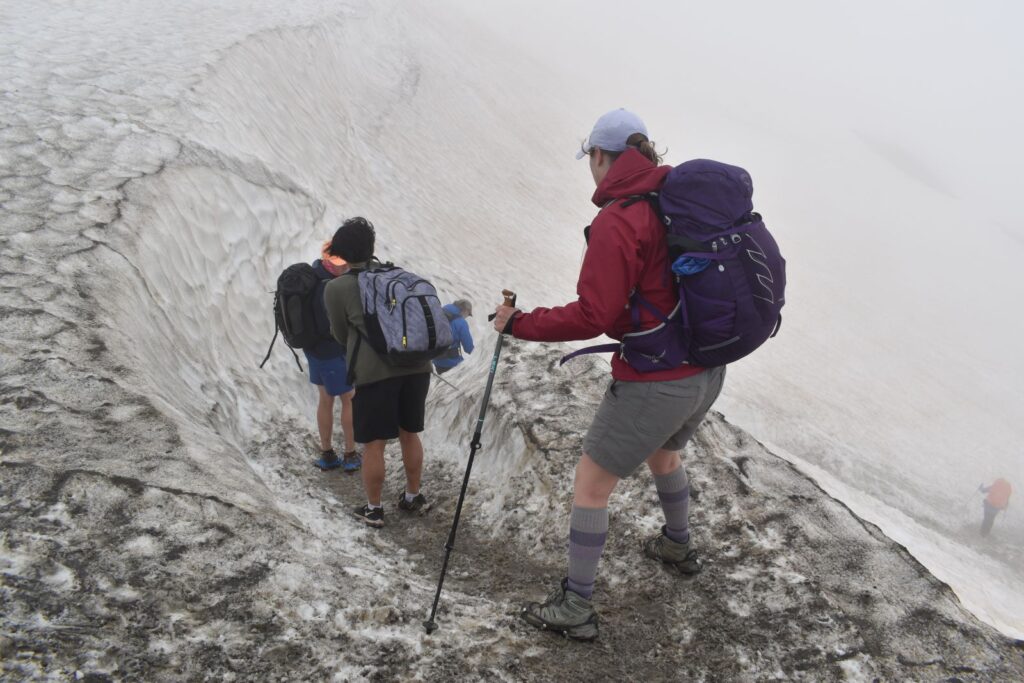
Gear & Accessories to Pack for the TMB
Gear needs vary for backpackers and hut-to-hut hikers.
Most people tackle the TMB as a 1-2 week trip. However, backpackers can pack as if it’s a two-day trip because they don’t need to carry much food and water. See our backpacking gear list for recommendations – and our top picks for the best backpacking tents, sleeping bags, sleeping pads, and backpacks.
Day hikers need to carry a few additional items that inns and rifugios require.
Here’s a quick overview of additional gear advice and recommendations:
- Day packs: If you’re day-hiking the TMB without luggage transfer service, consider a 30-35L daypack the ideal size. If you do have a luggage transfer, a daypack around 25L may be enough. See our recommendations for the best hiking daypacks.
- Backpacks: If you have decent gear, most backpackers should be good with a 40- to 50-liter backpacking backpack or ultralight backpack for the Tour du Mont Blanc.
- Rain Cover: To protect your belongings from the elements, you will need a rain cover for your pack. Either buy a day pack/backpack that includes a rain cover (e.g. Osprey Stratos) or purchase a separate rain cover that fits your pack dimensions.
- Hydration. Potable water is readily available on the Tour du Mont Blanc, but hikers should carry at least 1.5 liters to get from water source to water source. Here are our recommended water bottles and hydration bladders to carry in your pack.
- Trekking poles can spare your joints (especially knees) on the TMB’s steep terrain and improve your traction on snow and ice. Here are our top trekking poles.
- Sleeping Bag Liner. Most rifugios on the TMB provide basic bedding but require all guests to bring their own sleeping bag liner to keep beds more hygienic.
- Sun protection: Since sun is severe at high elevations, we recommend packing sunblock, sunglasses, and perhaps a sun shirt to protect against harmful UV rays and painful sunburns.
- Travel Towel. Some rifugios provide towels for showers, but not all of them. Please read the fine print for your bookings – or just carry a quick-drying travel towel.
- Travel Duffle. If you book a luggage transfer service, you may need to pack your extra belongings in a soft-sided travel duffle or backpack (since most services don’t allow suitcases). Here are our picks for the best duffle bags and travel backpacks. Keep in mind your luggage transfer service’s specific weight and size limits.

Conclusion
It’s no accident that the Tour du Mont Blanc is one of Europe’s most popular treks. The mountains are gorgeous, and the range of lodging and camping options appeals to a wide range of outdoor adventurers.
Of course, all those options also make the TMB tougher to plan than many hiking trips. We hope this comprehensive guide to hiking the TMB has gotten you stoked on the trip and has set you up to crush each of your decision points, so you can book the trip of a lifetime.
The post A Complete Guide to Hiking the Tour Du Mont Blanc appeared first on CleverHiker.
